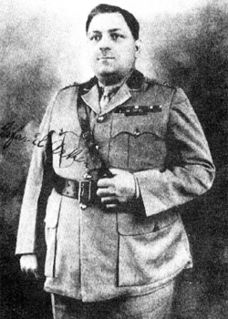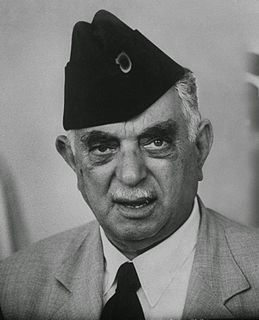| |||||||||||||||||||
All 108 seats in the Chamber of Deputies of Iraq 55 seats needed for a majority | |||||||||||||||||||
|---|---|---|---|---|---|---|---|---|---|---|---|---|---|---|---|---|---|---|---|
| |||||||||||||||||||
| |||||||||||||||||||
Parliamentary elections were held in Iraq between 10 December 1936 and 20 February 1937 to elect the members of Chamber of Deputies of Iraq. [1] [2]
| |||||||||||||||||||
All 108 seats in the Chamber of Deputies of Iraq 55 seats needed for a majority | |||||||||||||||||||
|---|---|---|---|---|---|---|---|---|---|---|---|---|---|---|---|---|---|---|---|
| |||||||||||||||||||
| |||||||||||||||||||
Parliamentary elections were held in Iraq between 10 December 1936 and 20 February 1937 to elect the members of Chamber of Deputies of Iraq. [1] [2]
After the 1936 military coup led by Bakr Sidqi, disagreement between the parliament led by deposed Prime Minister Yasin al-Hashimi and the left-leaning military government presided over by Hikmat Sulayman, led to the dissolution of parliament on 31 October 1936. [2] [3] [1] The new elections started in December 1936 and were complete by 20 February 1937.
A bloc supportive of coup leader Bakr Sidqi and members of the leftist Popular Reform Party won the elections and were the most prominent political groups in the new parliament. [3] [1] [4] Both groups supported Hikmat Sulayman's government. The new parliaments also included military officers, tribal leaders, nationalists and independent members. Later, the Popular Reform Party was accused of having communist ideology, and was dissolved. [4]
Bakr Sidqi and another coup leader were assassinated on 12 August 1937 in Mosul. After losing the support of the military, Sulayman resigned on 17 August 1937. [5] Parliament was dissolved on 26 August 1937 and fresh elections were held on 18 December 1937.

Ja'far Pasha al-Askari served twice as prime minister of Iraq: from 22 November 1923 to 3 August 1924; and from 21 November 1926 to 31 December 1927.

Yasin al-Hashimi, born Yasin Hilmi Salman, was an Iraqi politician who twice served as the prime minister. Like many of Iraq's early leaders, al-Hashimi served as a military officer during Ottoman control of the country. He made his political debut under the government of his predecessor, Jafar al-Askari, and replaced him as prime minister shortly after, in August 1924. Al-Hashimi served for ten months before he was replaced, in turn by Abd al-Muhsin as-Sa'dun. Over the next ten years he filled a variety of governmental positions finally returning to the office of prime minister in March 1935. On 30 October 1936, Hashimi became the first Iraqi prime minister to be deposed in a coup, which was led by General Bakr Sidqi and a coalition of ethnic minorities. Unlike al-Askari, who was then his minister of defense, al-Hashimi survived the coup and made his way to Beirut, Lebanon, where he died three months later. His older brother and close ally, Taha al-Hashimi, served as Prime Minister of Iraq in 1941.

Jamil Al Midfai was an Iraqi politician. He served as the country's prime minister on five separate occasions.

Bakr Sidqi al-Askari was an Iraqi general of Kurdish origin, born in 1890 in Kirkuk and assassinated on 11 August 1937, at Mosul.

Hikmat Sulayman was prime minister of Iraq from October 30, 1936 to August 12, 1937 at the head of a Party of National Brotherhood government.
The Treaty of Saadabad was a non-aggression pact signed by Turkey, Iran, Iraq and Afghanistan on July 8, 1937, and lasted for five years. The treaty was signed in Tehran's Saadabad Palace and was part of an initiative for greater Middle Eastern-Oriental relations spearheaded by King Mohammed Zahir Shah of Afghanistan. Ratifications were exchanged in Tehran on June 25, 1938, and the treaty became effective on the same day. It was registered in League of Nations Treaty Series on July 19, 1938.
Mohammed Hadid was an Iraqi economist, democracy advocate, Minister of Finance of Iraq between 1958 and 1963 and the father of internationally recognized architect Dame Zaha Hadid.
1935 Rumaytha and Diwaniyya revolt or the 1935–1936 Iraqi Shia revolts consisted of a series of Shia tribal uprisings in the mid-Euphrates region against the Sunni dominated authority of the Kingdom of Iraq. In each revolt, the response of the Iraqi government was to use military force to crush the rebellions with little mercy. The administrative task of this forceful disciplining of the Shi'a tribes fell to General Bakr Sidqi – the same man responsible for the brutal massacre of Assyrians in 1933.
The 1936 Iraqi coup d'état, also known as the Bakr Sidqi coup, was initiated by general Bakr Sidqi in order to overthrow Prime Minister Yasin al-Hashimi of the Kingdom of Iraq. The coup succeeded in installing Sidqi's ally Hikmat Sulayman as the new Prime Minister, while Sidqi was de facto ruler of Iraq as powerful Chief of Staff. Bakr Sidqi's reign would be short; he was assassinated the next year in Mosul, and Sulayman was obliged to resign his post.
The al-Ahali Group was a political association formed in 1930 by a collection of non-sectarian, middle class Iraqi youth frustrated with the Iraqi monarchy. Although it was not an official party, it was a successor to the Watani (National) party and home to several important Iraqi Cabinet and Parliament members, including Ja’far Abu al-Timman, Hikmat Sulayman, Kamil Chadirji, and Mohammed Hadid. Perhaps more importantly, its history illustrated the often complex task of navigating reform in the ideological and socio-political climate that predominated under the monarchy. It transformed from a radical left youth organization, to a more moderate reformist group under the aforementioned senior politicians, to an unfortunate accomplice in the Bakr Sidqi coup, and finally dissolved in protest over said coup's brutality and disregard for reform.

Parliamentary elections were held in Iraq on 20 October 1930 to elect the members of the Chamber of Deputies. For every twenty thousand male citizens, one Member of Parliament was elected to the Chamber of Deputies (Majlis an-Nuwwab), the dominant chamber of Parliament over the Senate. It was the third election since the establishment of the parliament.
Parliamentary elections were held in Iraq in 1928, with the final day of voting on 9 May, to elect the members of Chamber of Deputies. They were the second elections under the 1925 constitution. There were many complaints about the integrity of the elections and the way the government handled them, with some candidates collating evidence of vote manipulation. The opposition Independence Party and Iraqi National Party wrote a letter to the British Prime Minister complaining about the Iraqi government's violation of electoral law, demanding an investigation, and offering to pay for its cost. Nevertheless, the newly elected council convened on 13 May 1928 and elected Abdul-Aziz Al-Qassab, the interior minister in Al-Saadoun government, as Speaker.
Parliamentary elections were held in Iraq in 1933 to elect the members of the Chamber of Deputies. Although the Government Bloc led by incumbent Prime Minister Naji Shawkat won the most seats, it quickly disintegrated after the elections, allowing Rashid Ali al-Gaylani to become Prime Minister.
Parliamentary elections were held in Iraq on 6 December 1934 to elect the members of the Chamber of Deputies.
Parliamentary elections were held in Iraq on 4 August 1935 to elect the members of the Chamber of Deputies.
Jafar Abu al-Timman was an Iraqi politician.
Parliamentary elections were held in Iraq on 18 December 1937 to elect the members of Chamber of Deputies.
Parliamentary elections were held in Iraq between 20 August and 5 October 1943. The election of the secondary voters was held between 20 and 31 August 1943, whilst the election of the members of Chamber of Deputies was held on 5 October 1943.
Parliamentary elections were held in Iraq on 29 April 1939 to elect the members of the Chamber of Deputies.
Kamil Chadirji, also spelled Kamil al-Chadirji or Kamel al-Chaderji, was an Iraqi politician, photographer, lawyer, activist, and founder of the National Democratic Party in Iraq. He served as a member of the Chamber of Deputies of Iraq in the 1920s and 1950s. He was the father of notable modernist architect, Rifat Chadirji and political leader, Naseer al-Chaderchi. He is noted for founding the National Democratic Party with a left-wing program and was an influential political figure in political life who opposed the monarchy and pursued a social reform agenda.